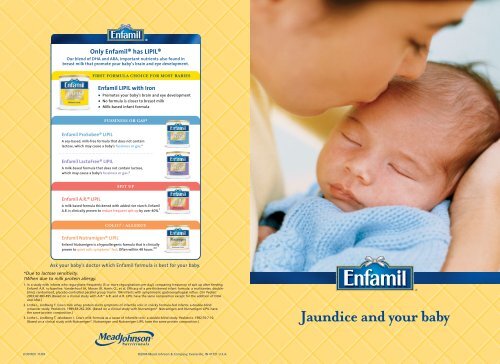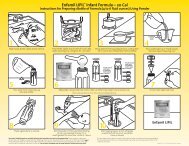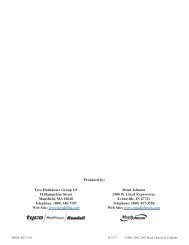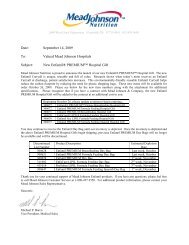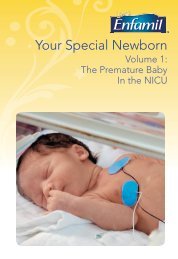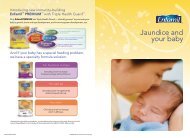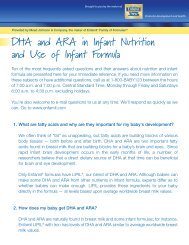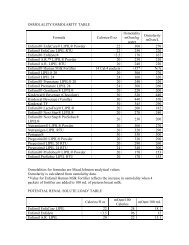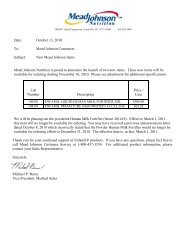Jaundice_LF_30_11_04.+ - Mead Johnson Nutrition
Jaundice_LF_30_11_04.+ - Mead Johnson Nutrition
Jaundice_LF_30_11_04.+ - Mead Johnson Nutrition
- No tags were found...
Create successful ePaper yourself
Turn your PDF publications into a flip-book with our unique Google optimized e-Paper software.
*Due to lactose sensitivity.†When due to milk protein allergy.1. In a study with infants who regurgitate frequently (5 or more regurgitations per day), comparing frequency of spit up after feedingEnfamil A.R. to baseline. Vanderhoof JA, Moran JR, Harris CL, et al. Efficacy of a pre-thickened infant formula: a multicenter, doubleblind,randomized, placebo-controlled parallel group trial in 104 infants with symptomatic gastroesophageal reflux. Clin Pediatr.2003;42:483-495.(Based on a clinical study with A.R. ® A.R. and A.R. LIPIL have the same composition except for the addition of DHAand ARA.)2. Lothe L, Lindberg T. Cow’s milk whey protein elicits symptoms of infantile colic in colicky formula-fed infants: a double-blindcrossover study. Pediatrics. 1989;83:262-266. (Based on a clinical study with Nutramigen ® . Nutramigen and Nutramigen LIPIL havethe same protein composition.)3. Lothe L, Lindberg T, Jakobsson I. Cow’s milk formula as a cause of infantile colic: a double-blind study. Pediatrics. 1982;70:7-10.(Based on a clinical study with Nutramigen ® . Nutramigen and Nutramigen LIPIL have the same protein composition.)<strong>Jaundice</strong> and your baby<strong>LF</strong><strong>30</strong> REV <strong>11</strong>/04©2004 <strong>Mead</strong> <strong>Johnson</strong> & Company, Evansville, IN 47721 U.S.A.
Dear Parents,What a wonderful, exciting time for you! As new parents, yourdays are now filled with amazing firsts you’re experiencingwith your new baby. And like most new parents, you’reprobably trying to learn and understand as much as you canabout caring for him.One of the challenges new parents may face is how to care fortheir baby who has jaundice. Many new babies develop thisvery common condition during the first few days of life. Abouthalf of all full-term babies, and more than three-fourths ofpremature babies, are affected by this condition. <strong>Jaundice</strong>,which comes from the French word, “jaune,” meaning yellow,causes your baby’s skin and whites of the eyes to turnsomewhat yellow. It’s important to note that jaundice normallydoesn’t cause any reason for concern. But the more you knowabout jaundice, the better you’ll know how to care for yourbaby who’s affected by it.Sometimes, jaundice resolves on its own. Or, your baby mayneed treatment for his jaundice. 1 Your baby’s doctor will talkwith you about the best way to treat your baby’s jaundice.We hope you find this guide helpful as you learn more abouthow to care for your baby who has jaundice. It’s easier to relax,and enjoy your new baby even more, when you know you’remaking the right decisions about how to care for him.Your Friends at <strong>Mead</strong> <strong>Johnson</strong> <strong>Nutrition</strong>alsMaker of The Enfamil Family of Formulas®1
UnderstandingjaundiceMaybe you’ve heard your friends who are mothers talk abouthow their babies were “jaundiced” shortly after birth. Manynormal, healthy infants develop a yellowish tinge to their skinand the whites of their eyes during the first few days of life.This condition is “physiologic jaundice,” the most commontype of jaundice in newborns. <strong>Jaundice</strong> is a yellow color thatappears in the skin shortly after birth and may continue intothe second week of life for the baby who’s breast-feeding. 2Normally, the yellow discoloration appears first on your baby’sface, then on the chest and stomach, and works its way downto his legs and toes. It’s more likely to occur in boys or in babieswho lose a lot of weight right after delivery, or who havediabetic mothers, or whose mothers’ labor was induced.WHAT CAUSES JAUNDICE?When your baby has jaundice, it’s a sign that his body isbreaking down old red blood cells. Babies are born with a largenumber of these red blood cells, and soon after birth, thesecells begin to break down. This normal breakdown of old redblood cells causes a chemical to form called “bilirubin.”Everyone’s blood contains a small amount of bilirubin. <strong>Jaundice</strong>happens when bilirubin builds up faster than a newbornbaby’s liver can break it down and get rid of it in the stool.Too much bilirubin is what makes your baby’s eyes and skinlook yellow. 3Just because your baby slowly processes bilirubin doesn’tmean that he has liver problems. It just means that your baby’sliver isn’t as fully developed as it will be, sothere may be some delay in ridding his bodyof the bilirubin.WHEN JAUNDICE APPEARSYou may notice the yellowing color ofjaundice in your baby on the second or thirdday of life. If your baby is premature, it maynot appear until the third or fourth daybecause of his extremely immature liver.It’s good to know that newborn nurserynurses are trained to recognize the signsof jaundice. If they see signs of jaundice inyour baby, they’ll let your baby’s doctorknow about it right away.Typically, after worsening for a fewdays, jaundice will gradually disappear.Most babies with mild jaundice regaintheir healthy pink color withoutspecial treatment.Most babies withmild jaundiceregain theirhealthy pink colorwithout specialtreatment.23
Whentreatment isneededBilirubin is normally harmless in a healthy baby. But if it buildsup to an unusually high level and doesn’t go down, there isa risk of damage to your baby’s nervous system. 4 While thissounds very frightening, don’t be worried. Your doctor willorder blood tests to frequently check for a rise in bilirubin.If the levels rise above those considered safe, your baby willprobably be treated by special lights, or phototherapy.UNDER THE LIGHTSPhototherapy is treatment with special, bright lights.“Bililights” help break down the bilirubin in your baby’s body.These fluorescent lights are placed over your baby’s incubator.Your baby will wear a mask or eye patches while he’s under thelights to protect his eyes. He’ll also wear little or no clothing,so as much skin as possible can be exposed to the light. Thebililights are safe for his skin. Or, your baby may wear a bilivest– a fiber-optic pad wrapped around your baby’s middle thatallows more flexibility and eliminates the need to cover hiseyes during therapy.In very basic terms, the blue lightwaves from the bililightschange the structure of the molecules in the bilirubin. Thisallows the bilirubin to be moved to the liver, broken down,and eliminated from your baby’s body.While your baby is being treated with phototherapy, you maynotice his bowel movements are more frequent, loose, andmaybe even greenish in color. He may also sleep more, wakingonly for his feedings. Your baby’s phototherapy treatment maybe at home or in the hospital, where medical staff can watchhis progress. Normally, phototherapy treatment lasts for just afew days, until your baby’s liver matures enough to handle thebilirubin load. 4 While normal daylight has a similar effect, it’snot quite strong enough to help. 4 It’s also not a good idea toplace your baby in direct sunlight because of the danger ofsunburn. 4 Your baby’s doctor will let you know which treatmentis best for your baby, and how long he will need to be treated.HOW BREAST-FEEDING AFFECTS JAUNDICEBecause breast milk may interfere with the liver’s ability tobreak down bilirubin, a breast-fed baby may have jaundice fora longer period of time. If this happens with your baby, yourdoctor may suggest that you stop breast-feeding temporarily –usually no more than 48 hours – to help decrease the bilirubinlevels in your baby’s blood. 4 Doctors recommend this only if it’sabsolutely necessary, since your baby’s frequent sucking isimportant to building your milk supply.45
Don’t stopbreast-feedingwithout firstchecking withyour doctor.Don’t stop breast-feedingwithout first checkingwith your doctor. Often,breast-feeding morefrequently, or for longerperiods of time, may helpremove bilirubin throughthe stools. If your babyisn’t breast-feedingenough, he may be atgreater risk fordeveloping jaundice. 1Fortunately, once thistype of jaundicedisappears, you can startbreast-feeding againsince it usually doesn’trecur. 2 If you’re breastfeedingand must stop for any reason, besure to express your breast milk so you cankeep producing milk and resume nursingagain easily. 16Other types ofjaundiceYou’ve seen that jaundice is very common and easily treated.Occasionally, though, there are other factors that can causejaundice in an infant.PATHOLOGICAL AND OBSTRUCTIVE JAUNDICERarely, in an infant with jaundice, the bilirubin in his systemwill rise quickly. This usually means that the jaundice isabnormal, or pathologic. Pathological jaundice begins eitherearlier or later than physiologic jaundice, and the levels ofbilirubin are higher. It may mean that “hemolytic disease” ispresent, caused by the blood group incompatibility. Thisproblem may happen when the baby has a different Rh factorthan his mother. It can also be caused by other, oftenhereditary, blood or liver diseases, or by intrauterine orneonatal infections.If jaundice doesn’t develop until later, usually between oneand two weeks after birth, it could mean that the jaundice isobstructive – that an obstruction in the liver is causingproblems with the processing of bilirubin.If your baby is affected by one of these very rare types ofjaundice, keep in mind that pathologic and obstructivejaundice are also very treatable. Treatment may includephototherapy, exchange blood transfusions or surgery toremove obstructions. There’s even drug therapy that uses asubstance to restrict the production of bilirubin. Your baby’sdoctor will choose the best treatment for him.7
At Enfamil Family Beginnings ® , we provide thesupport you want, from a name you trust.• Up to $250 in babygifts and discountsfrom the maker ofEnfamil, and itspartners likeJCPenney® andFisher-Price®.• Information tohelp you and yourbaby during baby’sfirst year.• Up-to-date tipsfrom doctors anddevelopmentalexperts.FREEFisher-Price andJCPenney Portraits offersREFERENCES1. Younger Meek J, ed. American Academy of Pediatrics New Mother’s Guide to Breastfeeding.New York, NY: Bantam; 2002:79.2. Shelov S, ed. American Academy of Pediatrics Your Baby’s First Year. New York, NY: Bantam;1998:204.3. Younger Meek J, ed. American Academy of Pediatrics New Mother’s Guide to Breastfeeding.New York, NY: Bantam; 2002:78.4. Shelov S, ed. American Academy of Pediatrics Caring for Your Baby and Young Child Birth toAge 5. New York, NY: Bantam; 1998:134.Call 1-800-BABY123 or visitwww.enfamil.com to joinEnfamil Family Beginnings today.FREEPre- and postnatalinformationand up to $60 in checksfor purchase of formulaAnd best of all, it’s FREE!All information is kept strictlyconfidential. Offer limited tonew enrollments, one perhousehold and subject tochange without notice.Enfamil Family Beginningsprogram benefits may vary.8


